Guide: How to start with cryptocurrencies
Are you one of those who have heard of virtual coins - the crypto coins - and the huge profits around them, but you do not know where to start? This guide is made for beginners who want to trade/invest in virtual currencies (bitcoin, ethereum, ripple, etc.).
(guide available in Romanian - here - disponibil și în limba română)
The guide is divided in:
It should be understood that the field of virtual coins (crypto currencies) is huge. Every day new currencies (even tens) appear, but most of them are absolutely useless coins. Coinmarketcap (which is the most important website in the industry, you can find more about it in advice) monitors 1394 different coins at the moment this guide is written (markets represent the total trading pairs, the direct exchanges between different currencies). Other sites report between 1100 and 1300 coins. Many projects are abandoned, hacked, inactive, or directly scams. Finding projects that have the potential to grow enormously and generate profits and that have or will have a useful product in real life is really the treasure hunt and should be the main activity of the one who invests in the field.
(markets represent the total trading pairs, the direct exchanges between different currencies). Other sites report between 1100 and 1300 coins. Many projects are abandoned, hacked, inactive, or directly scams. Finding projects that have the potential to grow enormously and generate profits and that have or will have a useful product in real life is really the treasure hunt and should be the main activity of the one who invests in the field.
The first and most important virtual currency (currently) is bitcoin. Although there have been some attempts to make coins that only exist in virtual space, only bitcoin has resisted. A group of people or just one person who publishes under the pseudonym Satoshi Nakamoto (so far the real identity is unknown) established in 2009 the basics of bitcoin. Bitcoin is a software that runs on tens of thousands of computers connected to the Internet and they all know the same thing - all the transactions from the beginning to the present and, of course, the value of each wallet.
We could talk about many technical issues regarding bitcoin, but this is not the topic of this guide. It started with a whitepaper - a scientific article that explains the idea (there were discussions and even a website before, but the whitepaper was the most important). I recommend reading the paper because it builds the basics of the most important technology Satoshi has implemented, the blockchain (bitcoin is very important too, but not at the same level). Blockchain is the only link between all crypto currencies, they all have a blockchain or another (because there are many types in this case too). I certainly recommend understanding the term, and here is a video (17 minutes) that explains very well the concept of blockchain (link).
From a technical point of view, we can talk a lot about blockchain and bitcoin (any question is welcome in the comments section at the end of the guide), but this guide is about investments and transactions using virtual currencies. Over time, the price of Bitcoin has had a lot of ups and downs, so it's important to know that we are talking about a very volatile market with losses of even 94%!
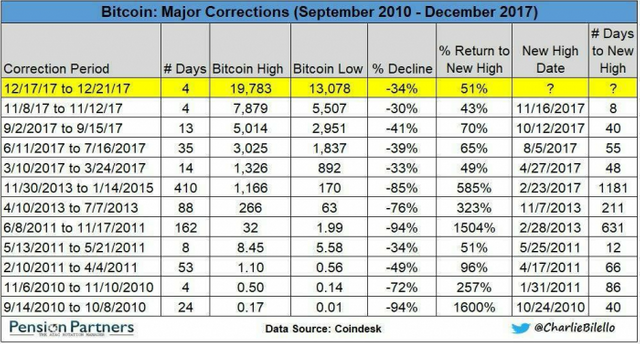
But it is equally true that profits have been huge too (after that drop of 94% followed an increase of 1504%!). Bitcoin started with absolutely no value (at the beginning there were given at least 50 coins for free for promotion only), and now, at the time of writing this article, it is worth ~ $ 15,000, but it was also $ 20,000 a month ago. What gives it this value? Very simple, demand and supply (and probably a lot of price manipulation in a market almost unregulated). Over time. investors have understood the purpose of bitcoin (or they had other interests) and have begun to buy more and more coins (one of the features of bitcoin is its rarity, at this time 16 million coins are in circulation and never in the future will be more than 21 million).
And although the increase from $ 0 to $ 20,000 is huge, the bitcoin is currently a relatively stable crypto currency. Compared to other virtual coins called altcoins (whatever is not bitcoin is altcoin) or shitcoins [whatever is not bitcoin is shitcoin : ) or unnecessary coins, etc.], 2017 was "stable" for bitcoin.
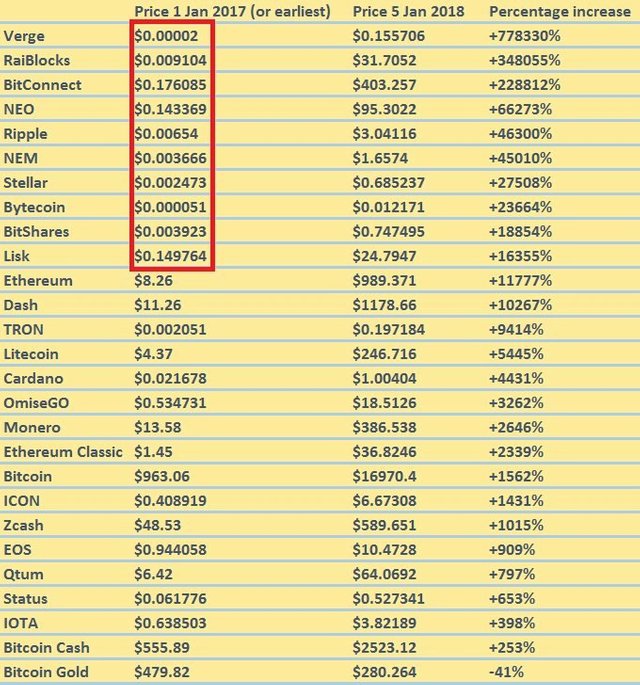
Who would have invested in these altcoins at the beginning of 2017 would have had some incomparable gains on other markets. For example, who invested $ 10 in the Verge virtual currency (or abbreviated $XVG) on January 1, 2017, exactly an year later it would have had $ 77,830.30 (an article about earnings in 2017 - here ). There are also coins that have decreased (out of those 1300 coins), but 2017 was an extraordinary year for most, having the highest gains since they appeared.
Most virtual coins are trading in pairs with bitcoin. So the first step is to buy bitcoin ($BTC). It is possible to acquire almost any Bitcoin subdivision, up to 0.00000001 BTC (or 1 satoshi, the smallest subdivision of a bitcoin, is called satoshi in honor of the creator). So if you only have $1000 to spend at the current rate you can buy 0.07025925 $BTC (approximate example).
Almost every big country has its own broker or exchange. You can buy bitcoin and pay with USD or EUR (or local currency) at a broker (google search "<country> bitcoin broker" and after you pick some read about them if they are legit websites). The biggest one, globally, is Coinbase. If it's unavailable in your country use Coinmama or AnyCoinDirect. You can use different terminals where you pay with cash or even ATMs (here's a map). You can even pay directly to users (via cash in person, vouchers, gift cards, etc.) and use websites where you don't need to register with an ID or give too many personal details by registering on LocalBitcoins(link) or Paxful(link). Some advantages and disadvantages bellow, in advice.
In this guide I will use Coinbase and then with bitcoins bought from there, trading them for altcoins on Binance.
(PS: it might be better to follow the steps to create an account on a exchange first or while you wait verification on Coinbase you can create the exchange account at Chapter 2.2 some rows bellow)
To buy Bitcoin, scroll up to the top of the main Coinbase page and click on Buy/Sell. A screen will pop up that looks like this:
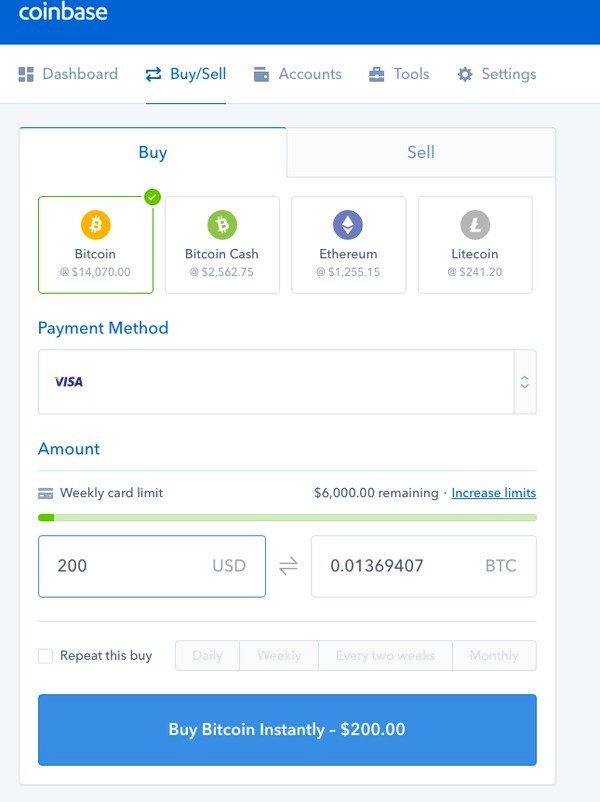
You can specify a dollar amount of bitcoin you want and the website will display the amount of BTC you would receive for that amount. In this case, the purchase is for $200 worth of bitcoin or 0.01369407 BTC. Then you just hit Buy instant and next and confirm everything and that's all.
Return to the dashboard and there will be a summary of the account and its activity, including the purchase of $200 worth of Bitcoin.
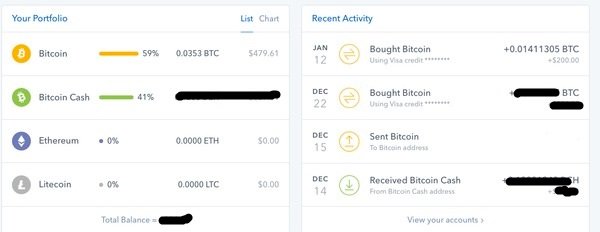
Now you want to send those bitcoins to an exchange so you can buy some altcoins. Jump into your Coinbase and then at the top of your screen select Accounts. (If you’re on mobile then Accounts will be at the bottom of your screen). Next, choose the cryptocurrency that you want to send from your wallets.
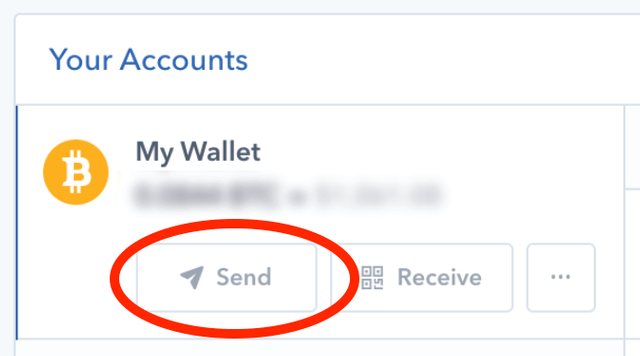
Your bitcoin address can be obtained in different ways (more about this bellow, in advice), but in this guide we will use an address generated by an exchange (probably the easiest method and the one recommended for small amounts of money). After you follow the steps below (chapter 2.2), and you have a bitcoin address, paste it here. After some minutes (10-30 minutes) the bitcoins will be moved from Coinbase to Binance and then you can start trading.
Registration is very quick and simple - Register (up right), fill in the fields correctly and then confirm the account from the email you received. Going back to the site click Login (log in with your new credentials) and from there choose the Funds - Balances menu.
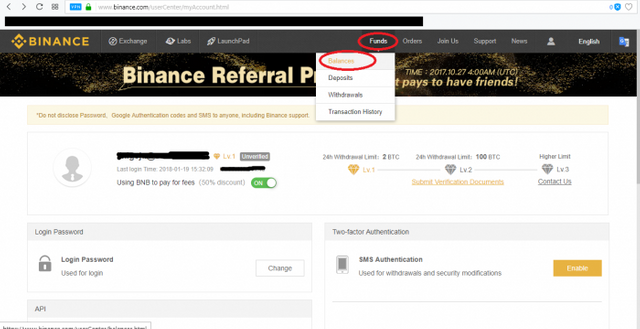
Search for BTC Bitcoin in the new window as in the image below and choose the Deposit button.

You can find the desired address in the BTC Deposit Address section in the new window. The address that is generated is unique and it is the address that has to be used above (at the broker part), at the last step from Coinbase (address, public address, wallet represent the same notion; it can be shared with anyone to receive bitcoins, but only you have access to them and only you can move them, trade them, etc.).
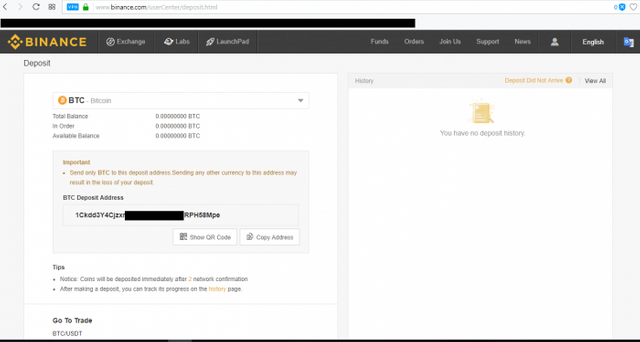
After a few minutes the bitcoins bought with USD from Coinbase will reach the address generated by Binance, and after a few more minutes the transaction will be confirmed by Binance (10-30 minutes in total).
Now you can trade any Bitcoin/Altcoin pair offered by Binance. You select the Exchange > Basic menu, and in the new page you search for the desired currency in the BTC column. For this example, I chose the BAT/BTC pair.
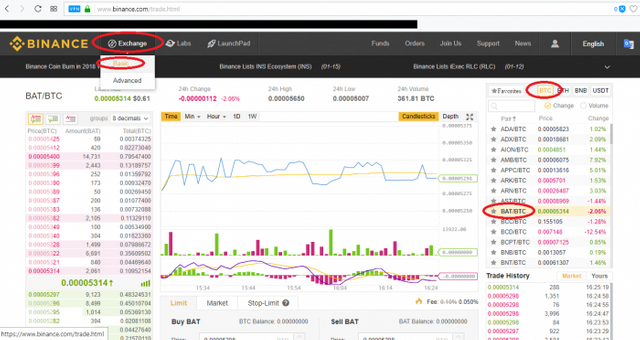
Now you can start trading virtual coins. Anyone who invests in crypto coins must become accustomed to such windows, it is the main buy/sell window. I divided the screen into several sections to make it easier to understand. A more detailed explanation of the window follows immediately after the image below.
(PS: To summarize, who wants to buy BAT, in the middle of the bottom of the page, in the Market section choose Buy BAT, type in the Amount field the exact number of coins you wish to buy or select one of the percentages suggested to allocate that percentage from the total available BTC in exchange for BAT).
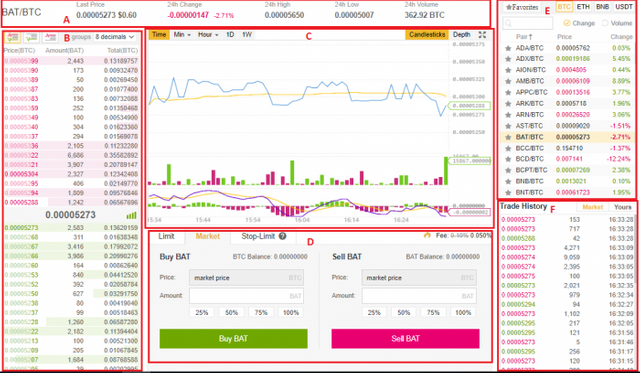
Section A displays:
Section B presents the Order Book, divided into two parts, showing the (purchasing and selling) orders closest to the average price:

Section C shows the price graph for the selected time period. You can change multiple graph view parameters with the top left buttons. There are also some technical analysis indicators at the bottom of the section, but their use is much more complex and does not fit into the guide (some details bellow in research and in advice).

In the most important part, in section D, you actually make orders. For simplicity, you choose the Market category (here the user is automatically assigned the best price). Then, in the Amount field of the Buy BAT section, write down the total number of BAT coins you want. Or, you can use the percentages below the Amount field to allocate a percentage of the total BTC amount available to buy the virtual coin BAT.

Section E shows the pairs available for trading. If you bought bitcoin coins ($BTC), using the previous chapter of this guide, you can buy any virtual coins from the BTC column (you can see last coin prices and price differences of the past 24 hours).

In section F, the last completed orders are displayed. In the picture the last order was at 16:33:28, 153 BAT coins were sold for the price of 0.00005273 BTC per BAT coin. The value appears in red because the average price has fallen after this exchange - green appears when the price increases..

And that's all.
If you want the reverse process (very briefly) - you sell the BAT coins available for BTC in the Binance exchange, then from Account in Coinbase, on Bitcoin ($BTC) you select Receive and copy the address, you return with that address to Binance and from Funds > Withdrawals from Binance, choose Bitcoin withdrawal and enter the address provided by Coinbase.
I listed a few options at the beginning of the guide, but there are a lot more. Coinbase (link) is by far the biggest international one, but it's not available worldwide. You can use as an alternative Coinmama(link) or Anycoindirect(link). By using a broker you pay with USD or EURO (or local currency) and you get bitcoin or a limited number of crypto coins.
To buy other coins the user has to register at an exchange. The biggest ones are: Binance(link) - recommended, Bit-z(link) 2nd recommendation, Bibox(link) - a great new exchange, HitBTC(link), Cryptopia(link). Or else CoinExchange(link), YoBit(link), C-cex(link), COSS(link), Bitbay(link), Bleutrade(link), Exmo(link), Cex(link), Mercatox(link), Altcoinexchange(link), Gatecoin(link), Kucoin etc. There are also these very large ones Bittrex(link), Bitstamp(link), Bitfinex(link) or Kraken(link) but the problem in the recent weeks has been that a lot of people have entered the world of virtual coins and this huge influx of new members overwhelmed all exchanges and that is why many exchanges have decided to suspend the registration of new members for a period of time not yet communicated.
That's why I gave this long list of exchanges and brokers because it is not known when they will also disable the registration of new members and I recommend everyone to register on all these sites or on as many as you can! It takes several hours, but this strategy worked for me (a coin may be available on a particular exchange only).
There is no perfect rule of what to look for and read, what sources of information are to be trusted or where to find the best tips. It's best not to believe anything on the internet. Whoever invested in a coin at a very high price now will promote that currency all the time hoping it will influence as many as possible to buy and so the price will increase (and he and his group will sell high). Those who have not yet bought will invent lies, discredit anything about a coin hoping that people will believe and sell, and so the price will drop (and he and his group will buy low). Many friends will advise you to buy a particular coin because they have heard it will grow a lot, etc. Although it may not be badly intended, it is certainly poorly informed and must be avoided. No one can know how a coin will evolve over the next 5 minutes or the next 3 years! Check the information from multiple sources and draw a conclusion yourself.
Very good sources of research:
(guide available in Romanian - here - disponibil și în limba română)
The guide is divided in:
- Introduction
- Investment/Trading
- Broker: USD>Bitcoin using Coinbase
- Exchange: Bitcoin>Altcoins using Binance
- Other exchanges and brokers
- Research
- Advice
- Finish
1. Introduction
The most important activity to be done by someone who wants to start any investment is a thorough documentation (especially in a very high-risk market like virtual coins)! This guide is just a first step, I recommend a few weeks, even months, of study and documentation in the field before investing the first money.It should be understood that the field of virtual coins (crypto currencies) is huge. Every day new currencies (even tens) appear, but most of them are absolutely useless coins. Coinmarketcap (which is the most important website in the industry, you can find more about it in advice) monitors 1394 different coins at the moment this guide is written
 (markets represent the total trading pairs, the direct exchanges between different currencies). Other sites report between 1100 and 1300 coins. Many projects are abandoned, hacked, inactive, or directly scams. Finding projects that have the potential to grow enormously and generate profits and that have or will have a useful product in real life is really the treasure hunt and should be the main activity of the one who invests in the field.
(markets represent the total trading pairs, the direct exchanges between different currencies). Other sites report between 1100 and 1300 coins. Many projects are abandoned, hacked, inactive, or directly scams. Finding projects that have the potential to grow enormously and generate profits and that have or will have a useful product in real life is really the treasure hunt and should be the main activity of the one who invests in the field.
The first and most important virtual currency (currently) is bitcoin. Although there have been some attempts to make coins that only exist in virtual space, only bitcoin has resisted. A group of people or just one person who publishes under the pseudonym Satoshi Nakamoto (so far the real identity is unknown) established in 2009 the basics of bitcoin. Bitcoin is a software that runs on tens of thousands of computers connected to the Internet and they all know the same thing - all the transactions from the beginning to the present and, of course, the value of each wallet.
We could talk about many technical issues regarding bitcoin, but this is not the topic of this guide. It started with a whitepaper - a scientific article that explains the idea (there were discussions and even a website before, but the whitepaper was the most important). I recommend reading the paper because it builds the basics of the most important technology Satoshi has implemented, the blockchain (bitcoin is very important too, but not at the same level). Blockchain is the only link between all crypto currencies, they all have a blockchain or another (because there are many types in this case too). I certainly recommend understanding the term, and here is a video (17 minutes) that explains very well the concept of blockchain (link).
From a technical point of view, we can talk a lot about blockchain and bitcoin (any question is welcome in the comments section at the end of the guide), but this guide is about investments and transactions using virtual currencies. Over time, the price of Bitcoin has had a lot of ups and downs, so it's important to know that we are talking about a very volatile market with losses of even 94%!

But it is equally true that profits have been huge too (after that drop of 94% followed an increase of 1504%!). Bitcoin started with absolutely no value (at the beginning there were given at least 50 coins for free for promotion only), and now, at the time of writing this article, it is worth ~ $ 15,000, but it was also $ 20,000 a month ago. What gives it this value? Very simple, demand and supply (and probably a lot of price manipulation in a market almost unregulated). Over time. investors have understood the purpose of bitcoin (or they had other interests) and have begun to buy more and more coins (one of the features of bitcoin is its rarity, at this time 16 million coins are in circulation and never in the future will be more than 21 million).
And although the increase from $ 0 to $ 20,000 is huge, the bitcoin is currently a relatively stable crypto currency. Compared to other virtual coins called altcoins (whatever is not bitcoin is altcoin) or shitcoins [whatever is not bitcoin is shitcoin : ) or unnecessary coins, etc.], 2017 was "stable" for bitcoin.

Who would have invested in these altcoins at the beginning of 2017 would have had some incomparable gains on other markets. For example, who invested $ 10 in the Verge virtual currency (or abbreviated $XVG) on January 1, 2017, exactly an year later it would have had $ 77,830.30 (an article about earnings in 2017 - here ). There are also coins that have decreased (out of those 1300 coins), but 2017 was an extraordinary year for most, having the highest gains since they appeared.
2. Investment/trading
How can I buy Verge $XVG or Ripple $XRP? There is no method that is very simple or very easy for beginners.Most virtual coins are trading in pairs with bitcoin. So the first step is to buy bitcoin ($BTC). It is possible to acquire almost any Bitcoin subdivision, up to 0.00000001 BTC (or 1 satoshi, the smallest subdivision of a bitcoin, is called satoshi in honor of the creator). So if you only have $1000 to spend at the current rate you can buy 0.07025925 $BTC (approximate example).
Almost every big country has its own broker or exchange. You can buy bitcoin and pay with USD or EUR (or local currency) at a broker (google search "<country> bitcoin broker" and after you pick some read about them if they are legit websites). The biggest one, globally, is Coinbase. If it's unavailable in your country use Coinmama or AnyCoinDirect. You can use different terminals where you pay with cash or even ATMs (here's a map). You can even pay directly to users (via cash in person, vouchers, gift cards, etc.) and use websites where you don't need to register with an ID or give too many personal details by registering on LocalBitcoins(link) or Paxful(link). Some advantages and disadvantages bellow, in advice.
In this guide I will use Coinbase and then with bitcoins bought from there, trading them for altcoins on Binance.
(PS: it might be better to follow the steps to create an account on a exchange first or while you wait verification on Coinbase you can create the exchange account at Chapter 2.2 some rows bellow)
2.1 Broker USD > Bitcoin - Coinbase
I use Coinbase for buying bitcoins. Use this link to register and if you deposit 100$ you will receive 10$ free for registering via my link. It has some of the best rates and is by far the most used broker worldwide. Registering is very easy. Just hit Sign Up in top right corner and then complete the steps. After you verify your account via email you will be prompted to upload your ID and verify your bank account or credit card as you go. Simply follow the prompts as they appear to complete account set up. Once you have opened an account at Coinbase, you will see its dashboard with the price of Bitcoin (and Bitcoin Cash, but avoid it for now), Ethereum, and Litecoin, along with a chart of bitcoin.To buy Bitcoin, scroll up to the top of the main Coinbase page and click on Buy/Sell. A screen will pop up that looks like this:

You can specify a dollar amount of bitcoin you want and the website will display the amount of BTC you would receive for that amount. In this case, the purchase is for $200 worth of bitcoin or 0.01369407 BTC. Then you just hit Buy instant and next and confirm everything and that's all.
Return to the dashboard and there will be a summary of the account and its activity, including the purchase of $200 worth of Bitcoin.

Now you want to send those bitcoins to an exchange so you can buy some altcoins. Jump into your Coinbase and then at the top of your screen select Accounts. (If you’re on mobile then Accounts will be at the bottom of your screen). Next, choose the cryptocurrency that you want to send from your wallets.

Your bitcoin address can be obtained in different ways (more about this bellow, in advice), but in this guide we will use an address generated by an exchange (probably the easiest method and the one recommended for small amounts of money). After you follow the steps below (chapter 2.2), and you have a bitcoin address, paste it here. After some minutes (10-30 minutes) the bitcoins will be moved from Coinbase to Binance and then you can start trading.
2.2 Exchange Bitcoin > altcoins - Binance
Registering on an exchange can be very simple or in some cases impossible. For this guide I used the best exchange with the highest volume (when writing this guide) - Binance. Use this link to get to the registration page.Registration is very quick and simple - Register (up right), fill in the fields correctly and then confirm the account from the email you received. Going back to the site click Login (log in with your new credentials) and from there choose the Funds - Balances menu.

Search for BTC Bitcoin in the new window as in the image below and choose the Deposit button.

You can find the desired address in the BTC Deposit Address section in the new window. The address that is generated is unique and it is the address that has to be used above (at the broker part), at the last step from Coinbase (address, public address, wallet represent the same notion; it can be shared with anyone to receive bitcoins, but only you have access to them and only you can move them, trade them, etc.).

After a few minutes the bitcoins bought with USD from Coinbase will reach the address generated by Binance, and after a few more minutes the transaction will be confirmed by Binance (10-30 minutes in total).
Now you can trade any Bitcoin/Altcoin pair offered by Binance. You select the Exchange > Basic menu, and in the new page you search for the desired currency in the BTC column. For this example, I chose the BAT/BTC pair.

Now you can start trading virtual coins. Anyone who invests in crypto coins must become accustomed to such windows, it is the main buy/sell window. I divided the screen into several sections to make it easier to understand. A more detailed explanation of the window follows immediately after the image below.
(PS: To summarize, who wants to buy BAT, in the middle of the bottom of the page, in the Market section choose Buy BAT, type in the Amount field the exact number of coins you wish to buy or select one of the percentages suggested to allocate that percentage from the total available BTC in exchange for BAT).

Section A displays:
- pair of coins BAT/BTC;
- last price - 0.00005273 BTC and the approximate equivalent in dollars 0.60$ (to buy 1 coin of BAT you need to pay on average ~ 0.00005273 BTC or in short 1BAT = 0.00005273BTC);
- difference +/- compared to the price 24 hours ago (-2.71% or decreased with 0.00000147 BTC);
- 24h High and 24h Low are the maximum and minimum prices in the last 24 hours;
- 24h Volume is the total volume of traded BAT coins; in the last 24 hours, BAT coins were traded in a total of 362.92 BTC (bitcoins).

Section B presents the Order Book, divided into two parts, showing the (purchasing and selling) orders closest to the average price:
- In the upper half are displayed buying orders. Thus, at the best price, with red, there are 1242 BAT coins to buy at the price of 0.00005288 BTC per BAT coin and so on;
- In the lower half, the sales orders are displayed. Thus, at the best price, with green, there are 2583 BAT coins for sale at the price of 0.00005273 BTC per BAT coin and so on.

Section C shows the price graph for the selected time period. You can change multiple graph view parameters with the top left buttons. There are also some technical analysis indicators at the bottom of the section, but their use is much more complex and does not fit into the guide (some details bellow in research and in advice).

In the most important part, in section D, you actually make orders. For simplicity, you choose the Market category (here the user is automatically assigned the best price). Then, in the Amount field of the Buy BAT section, write down the total number of BAT coins you want. Or, you can use the percentages below the Amount field to allocate a percentage of the total BTC amount available to buy the virtual coin BAT.

Section E shows the pairs available for trading. If you bought bitcoin coins ($BTC), using the previous chapter of this guide, you can buy any virtual coins from the BTC column (you can see last coin prices and price differences of the past 24 hours).

In section F, the last completed orders are displayed. In the picture the last order was at 16:33:28, 153 BAT coins were sold for the price of 0.00005273 BTC per BAT coin. The value appears in red because the average price has fallen after this exchange - green appears when the price increases..

And that's all.
If you want the reverse process (very briefly) - you sell the BAT coins available for BTC in the Binance exchange, then from Account in Coinbase, on Bitcoin ($BTC) you select Receive and copy the address, you return with that address to Binance and from Funds > Withdrawals from Binance, choose Bitcoin withdrawal and enter the address provided by Coinbase.
2.2 Other exchanges and brokers
Obviously there is not just a broker (Coinbase) and not only one exchange (Binance).I listed a few options at the beginning of the guide, but there are a lot more. Coinbase (link) is by far the biggest international one, but it's not available worldwide. You can use as an alternative Coinmama(link) or Anycoindirect(link). By using a broker you pay with USD or EURO (or local currency) and you get bitcoin or a limited number of crypto coins.
To buy other coins the user has to register at an exchange. The biggest ones are: Binance(link) - recommended, Bit-z(link) 2nd recommendation, Bibox(link) - a great new exchange, HitBTC(link), Cryptopia(link). Or else CoinExchange(link), YoBit(link), C-cex(link), COSS(link), Bitbay(link), Bleutrade(link), Exmo(link), Cex(link), Mercatox(link), Altcoinexchange(link), Gatecoin(link), Kucoin etc. There are also these very large ones Bittrex(link), Bitstamp(link), Bitfinex(link) or Kraken(link) but the problem in the recent weeks has been that a lot of people have entered the world of virtual coins and this huge influx of new members overwhelmed all exchanges and that is why many exchanges have decided to suspend the registration of new members for a period of time not yet communicated.
That's why I gave this long list of exchanges and brokers because it is not known when they will also disable the registration of new members and I recommend everyone to register on all these sites or on as many as you can! It takes several hours, but this strategy worked for me (a coin may be available on a particular exchange only).
3. Research
Sending money and buying bitcoins can be very simple, especially after the first transaction. And buying other virtual coins - altcoins - is just as simple. The problem is when you have to decide exactly what to buy. The most time-consuming activity for an investor/trader in cryptocurrencies domain is research, studying different currencies.There is no perfect rule of what to look for and read, what sources of information are to be trusted or where to find the best tips. It's best not to believe anything on the internet. Whoever invested in a coin at a very high price now will promote that currency all the time hoping it will influence as many as possible to buy and so the price will increase (and he and his group will sell high). Those who have not yet bought will invent lies, discredit anything about a coin hoping that people will believe and sell, and so the price will drop (and he and his group will buy low). Many friends will advise you to buy a particular coin because they have heard it will grow a lot, etc. Although it may not be badly intended, it is certainly poorly informed and must be avoided. No one can know how a coin will evolve over the next 5 minutes or the next 3 years! Check the information from multiple sources and draw a conclusion yourself.
Very good sources of research:
- Official website of the coin;
- Twitter - one of my main sources of information when researching a coin. For example, when searching for a coin, use the $ followed by the coin shortcut - $XRP (link). An alternate interface for twitter is tweetdeck (link), in which it is much easier to track multiple columns;
- Bitcointalk - the main site in this field of crypto currencies. The site was created by Satoshi Nakamoto himself, and absolutely all coins are first announced here. If they do not appear here, then it's a very big question mark. There are even posts with thousands of discussion pages (eg announcing the launch of Bancor - link);
- CoinMarketCap - the oldest site that centralizes all currencies and their price over time. t is one of the most visited sites globally (alternatives - CryptoCompare, Coincap.io or WorldCoinIndex);
- Reddit - a kind of forum where various news, events, issues, etc. are announced. Each virtual currency has its subbreddit, which is dedicated only to that currency (eg for the IOTA currency exists r/IOTA - link);
- Telegram, discord or slack - these are chat apps. Most coins have official accounts, but there are also many other channels of discussion made by fans. There are many telegram groups (search google) that immediately announce the latest news in the market, and if you move very fast and buy until the news get to the rest of the world, you can make a big profit. I do not recommend this because fake news can (will) be promoted. I also have a discussion group that I moderate and where everyone is invited, including beginners - link discord channel;
- Coinmonsta - post the latest global news, news from Reddit, price charts, etc. in real time for many virtual coins. Very good for those who want to be up to date with the latest news;
- Coinmarketcal - a site where almost all the events that are going to happen for all coins are shared like in a calendar (alternatives CoinCalendar or Coindar);
- Video reviews on Youtube;
- Crypto currencies news on Steemit website;
- Google - maybe a little higher with a bigger priority, maybe even first.
- using a portfolio application. I personally use CoinTracking to retrieve different reports, track earnings, money and coins invested, etc. For my smartphone, I use a very simple app, Blockfolio, that just shows the number of coins and their value (plus graphics and small stuff) (alternative - Delta);
- using a specialized price chart site. Although it may be enough for some the charts from CoinMarketCap, one of the best sites is TradingView.
- mining - sharing computer resources with the network to support the project is rewarded with a certain number of coins (very briefly definition);
- investing;
- trading (long-term, mid-term or even day trading);
- short - betting on the fact that a coin will decrease in value instead of increasing (for professionals only, I recommend the site BitMEX);
- arbitrage - in an unregulated and highly fragmented market like the one of virtual coins, there are always differences between the price of a currency between different exchanges; if there are big differences and certain conditions are met you can buy a coin from one place and sell it more expensive on another exchange;
- ICO - buying new coins at the beginning of a project for a lot cheaper (theoretical) price;
- PoS and Masternode coins - there are some crypto currencies that offer a guaranteed number of coins for free if you keep coins in your wallet;
- airdrops - distribution of free coins;
- bounty - promoting or publishing articles about a particular project can be rewarded with coins.
4. Advice
- Be very careful of scams. Like everything on the internet, crypto is full of scams. Trust NO ONE. Don't trust someone who wants to help you store your coins, move or exchange them. Check multiple times the website you visit and its address, just one different letter and you can visit a cloned website where you just give directly to hackers your credentials. Never invest in projects that seems suspicious, all lending platforms or financial networking projects are ponzi schemes;
- Use a different email address with a complex and secure password. Ideal it would be to use multiple email addresses for every crypto related website, complex and different passwords and for big amounts of money different phone numbers. Install Google Authenticator app (or Authy, a better alternative) and enable 2 factor authentication every time it's available (every time follow all the steps carefully). If possible use a very safe computer (with no cracked programs installed), a virtual machine, isolated browsers, VPN, etc. (a great article here);
- Use of bitcoin network, of the blockchain, for doing a transaction from broker to exchange is not free. In fact there's a really big fee involved (complex graphs and how to understand them), which was even 50$ or more. For small transactions this matters a lot (there are technologies in development that will resolve this problem in the future). That's why you can buy Litecoin ($LTC) from the broker and then send them to a Litecoin address on the exchange and from there trade them for bitcoins (comparison between fees). This is a somehow more complex case that won't be explained here - beginners can ignore this and use only bitcoin;
- ALWAYS double check the address that you write/copy. Send virtual coins only between addresses of the same coin (bitcoin to bitcoin, litecoin to litecoin, ethereum to ethereum, etc). A simple mistake and you lose your coins forever!
- For small amounts, this guide is sufficient. If you have large and important amount of money in exchange, it is good to know that many exchanges have been broken by hackers. And then you should find a safer wallet (articles - link1, link2, link3). For more questions, use the comments section at the end of this guide or look for counseling from an expert;
- Brokers do not always have the best rates, but they are much better than a instant terminal or ATM or localbitcoins (or Paxful). The risk of buying bitcoins directly from other users is that authorities can track the history of transactions and they might be used in the past for illegal operations. The best option I consider to be Coinbase > Binance;
- The use of virtual coins for investments or transactions are two different concepts. I invest in projects with high potential in the near future (5-10 years), virtual coins that have use-case scenarios or I trade coins daily or weekly for speculative purposes;
- There are experienced investors and traders who find patterns in crypto coins price graphs and can approximate a certain value in the future. This method is called technical analysis (excellent articles here and a complete free course here);
- Always have a backup plan plus an investment/transaction and risk management. Never use more money than you are willing to consider the total loss of investment acceptable. Do not use money you really need (rent, food, borrowed, etc.). This is a very high risk market;
- Avoid pump-and-dump groups (just believe me, ignore them entirely). Do not buy being driven by emotions (when the price of a coin has grown so much that you have lost the right moment and then you quickly buy some, or when a coin decreases a lot to scare you and sell everything to recover a part of investment - usually these are very bad transactions; this is called FOMO - fear of missing out). Do not have blind faith in anyone, not even what I wrote (I'm no guru, no one is). Always check and draw a conclusion yourself (DYOR - do your own research);
- You will never buy exactly at the minimum and you will never sell at the maximum, try to be as close as possible to these limits (buy low, sell high). There will also be losses, there will be winnings, it is important that at the end, when you draw the line, to have a positive balance;
- Cryptocurrencies exchanges are opened 24/7!
5. Finish
Don't use this guide as a financial advise. Every action with your own money represents your sole responsibility! For every question use the comment section right bellow, someone (probably me) will answer ASAP. This guide uses referral links, i do win a very small part of the fees you pay anyway. You don't pay anything extra if you register using my links, in fact some exchanges even give you a smaller fee if you register using an affiliate link.Don't forget to share this guide, maybe you too have a friend, colleagues, family who wants to find more about cryptocurrencies and how to buy their first bitcoin! (use this short link - is.gd/cryptocoins - easier and faster to share)
*this guide first appeared on my blog (blog.dcoins.xyz)
Congratulations @liviux! You have received a personal award!
Click on the badge to view your Board of Honor.
Do not miss the last post from @steemitboard: